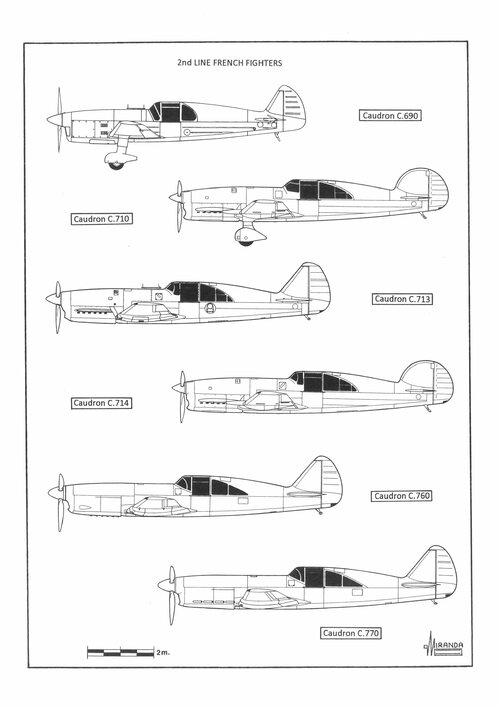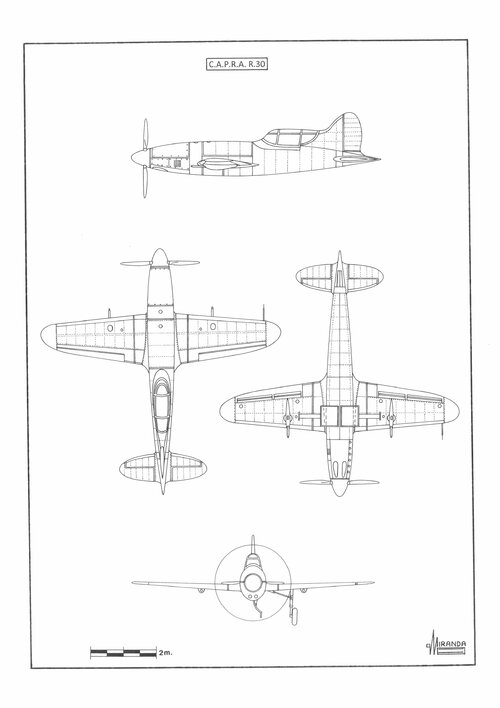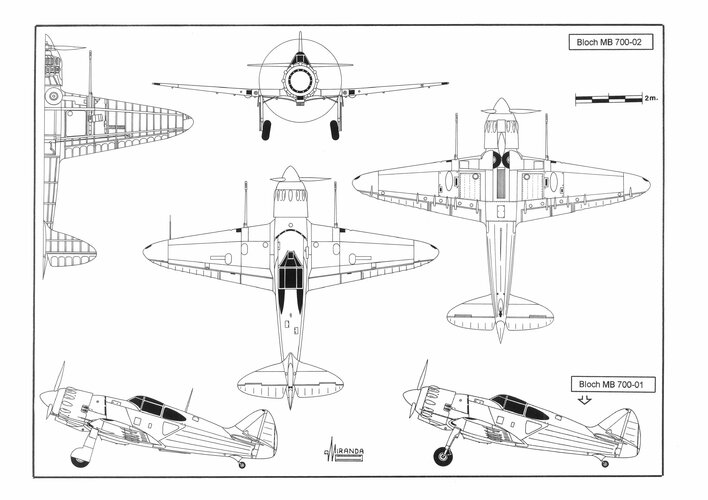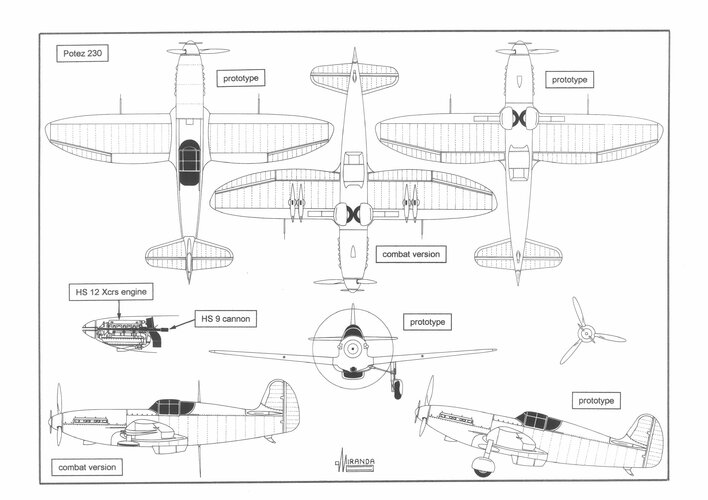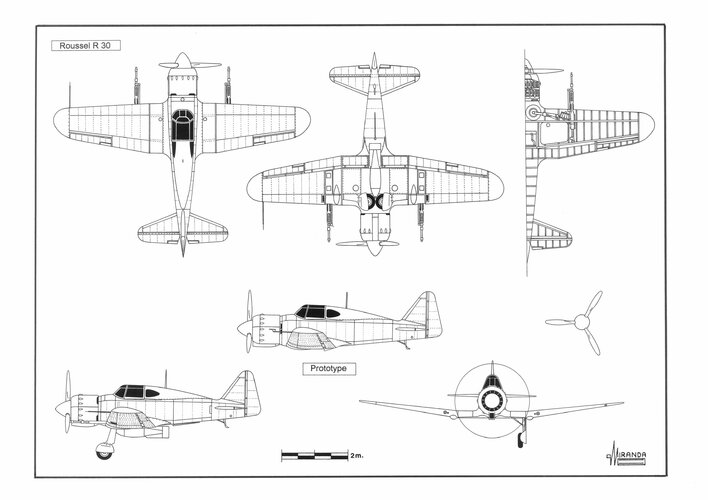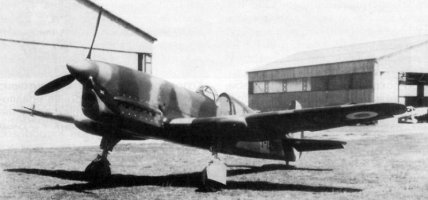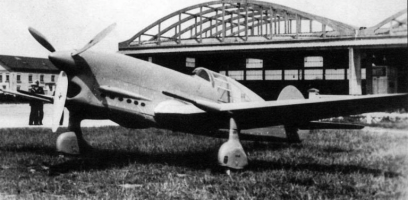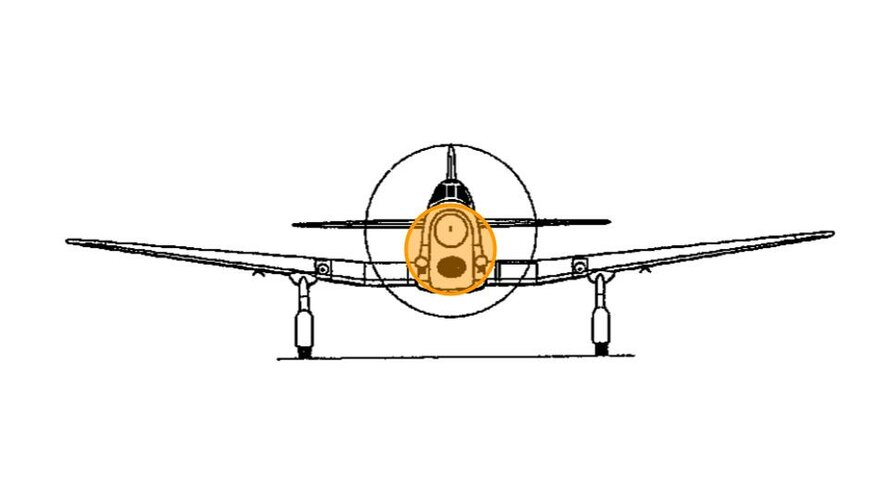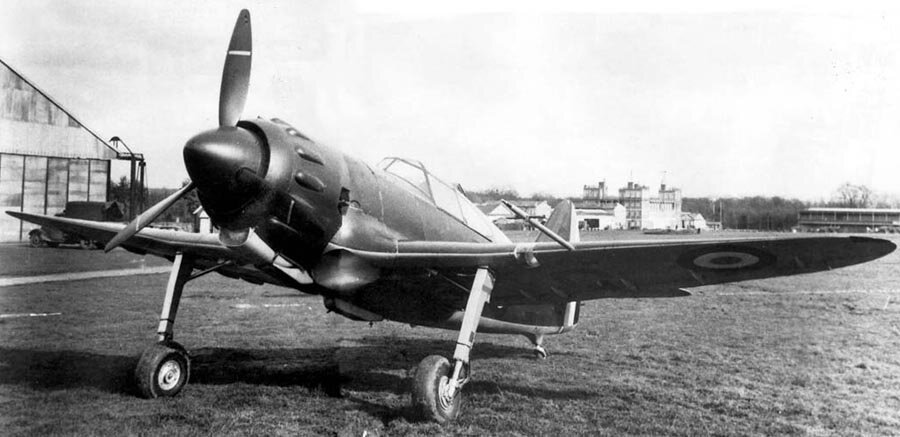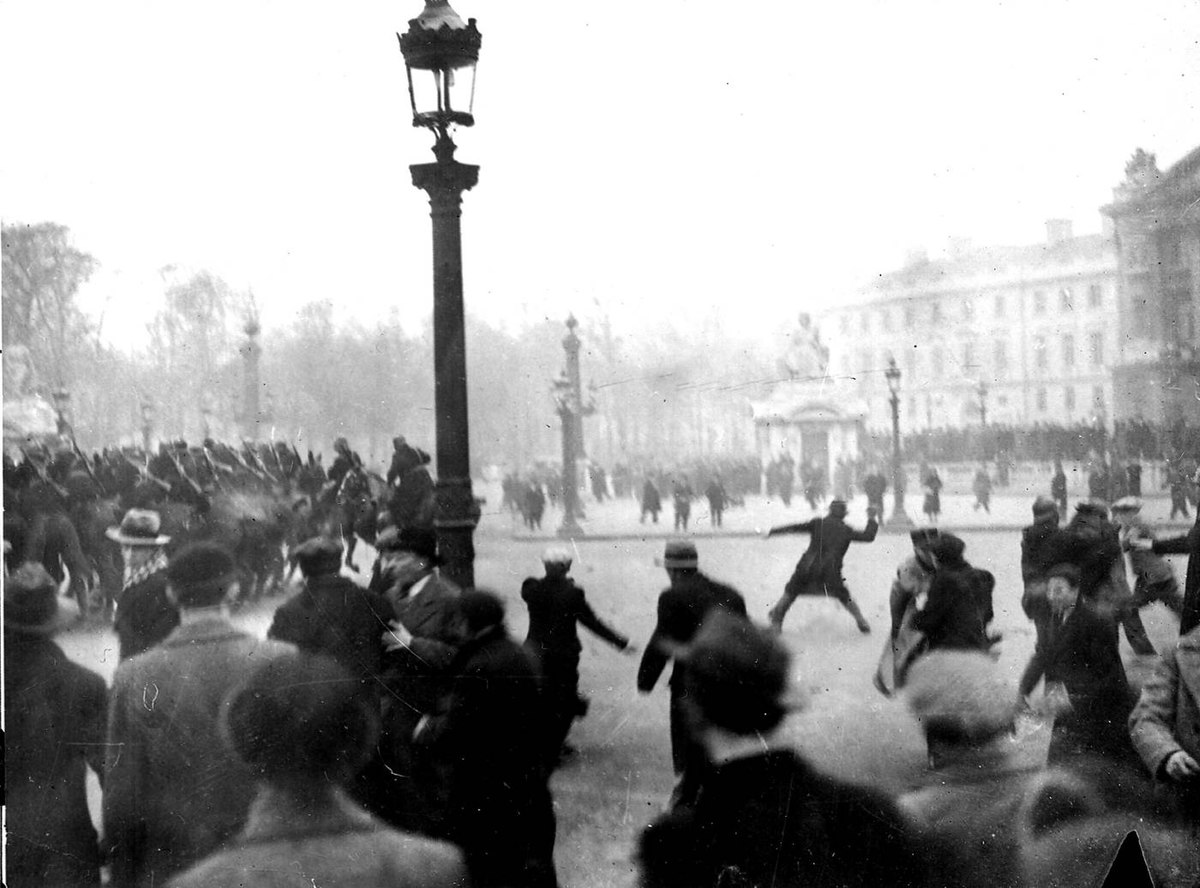The 'Panic Effect' caused by the Munich Agreement forced the French Government to carry out large massive purchases of foreign aircraft, initiating talks with the USSR for the acquisition of Polikarpov I-16 fighters, an operation that was cancelled after the German-Soviet non-aggression Pact. They placed orders for two-hundred Curtiss H.75A and hundred Curtiss H.81 (P-40) fighters to the USA and acquired forty Koolhoven FK.58 fighters to the Netherlands together with the license to manufacture them in Nevers-France. One Spitfire Mk.I was also purchased to Great Britain to study the compatibility of its engine with the D.520.
On March 1940
l’Armée de l’Air had 18 serviceable Koolhoven. During the Battle of France they were used to equip four
Patrouilles de Défense piloted by Poles. On June 25 ten of them had survived the combats.
The Curtiss H.81 did not arrive in time to prevent the fall of France and they were transferred to the RAF, but the H.75A performed well, fighting on equal terms with the Messerschmitt Bf 109 D during the
Phoney War and eluding the attacks of the Bf 109 E during the Battle of France, thanks to its greater manoeuvrability, but its armament of four machine guns proved to be insufficient to destroy German bombers.
During the period between both World Wars, the size and weight of the fighters was progressively augmented in parallel with the increasing power of the available engines. Against that general trend, there was a minority of aeronautical designers defending the small sized fighters, known as 'Jockey Fighters' at that time. This type of airplanes, if well designed, could generally compete in performance with the conventional fighters, using a less powerful engine, with an important save in fuel, manpower and strategic materials. They were also easier to maintain and store and their reduced size and weight helped to increase agility in combat, making more difficult to be seen by the rear gunners in the bombers, or by the pilots in the escort fighters, and their destruction required a higher consumption of ammunition.
At the beginning of World War II, the conventional fighters used to have 10 to 12 m of wingspan, operational weight of 2,500 to 3,500 kg and a maximum speed of 450 to 500 km/h. The light fighters of the time could be divided in two categories:
‘Jockey Fighters’, with less than 10 m. wingspan, maximum weight of 1,800 to 2,500 kg and the same speed than the conventional fighters.
‘Midget Fighters’, with less than 10 m wingspan, maximum weight of 600 to 1,800 kg and maximum speed of 350 to 400 km/h.
Potez 230
The Potez 230 inherited the most advanced elliptical wing of the time, built with an integral torque box, from its ancestor, Les Mureaux 190 light fighter, developed during the 30s. The philosophy of design of the Potez 230 was based on the specification
Chasseur Monoplace C1 (June 3, 1937), calling for one high-performance small airplane that could use some technical elements left aside by first line fighters.
Thus, the surplus of Hispano-Suiza H.S.12 Xcrs engines, H.S.9 cannons and MAC 34A machine guns coming from the obsolete Dewoitine D.510 fighters could go back to combat without overloading the French war production of H.S.12 Y-45, H.S.404 and MAC 34 M39, intended for the Dewoitine D.520. Would the new equipment be available in enough quantity, it would also had been used by the Potez 230 as it was compatible to both of them.
A prototype was built in the Potez C.A.M.S. factory of Sartrouville in 1939. During a series of tests performed in the Villacoublay test centre in March 1940, it reached the speed of 560 km/h being equipped with an H.S.12 Xcrs of just 680 hp (the Dewoitine D.520 reached 525 km/h and the Bf 109 E-1, 575 km/h with much more powerful engines). It was expected that the Potez 230 could fly at 622 km/h after the installation of one of the new H.S.12 Y-45 of 910 hp but it was captured by German forces in June and translated to a technical research centre of the Luftwaffe to study the wing construction system.
Technical data
Engine: one 680 hp Hispano-Suiza H.S.12 Xcrs twelve-cylinder ‘Vee’ liquid-cooled, driving a three-bladed Ratier airscrew with pneumatic variable-pitch. Armament: one 20 mm engine-mounted H.S.9 cannon and four 7.5 mm. MAC 34A machine guns mounted under the wings. Wingspan: 8.74 m, length: 7.57 m, height: 2.18 m, wing area: 10.97 sq.m, maximum weight: 1,800 kg, maximum speed: 560 kph.
Roussel R.30
The Roussel R.30 was conceived as a private venture ‘Jockey Fighter’ in answer to the
Programme technique A.23 (12 January 1937) that required a light fighter able to fly at 520 km/h. Construction of the prototype began at Courbevoie, flying for the first time equipped with a 690 hp Gnôme-Rhône 14 M7 engine in April 1939.
In August 1939 it was transferred to the
Centre d’Essais du Matériel Aérien (C.E.M.A.) for official trials, as a result of which it was recommended to install a more powerful engine to better use its excellent flying performances. During the Battle of France, the airplane was armed with two 20 mm Oerlikon FFS cannons mounted in the wings and some tests were performed for the installation of a bomb rack under the fuselage.
In combat, the R.30 could have destroyed any Luftwaffe bomber thanks to its high fire power of 2 Kg/sec, 2.8 times that of the Bf 109 E-1. In ground attack mode it would have had more possibilities to survive the Flak than the unfortunate Breguet 693 of the GBA 54 due to its high speed and small size. The only prototype was destroyed in Bordeaux-Mérignac airbase during a He111 bomb raid.
Technical data
Engine: one 690 hp Gnôme-Rhône 14 M7 of fourteen-cylinder, air-cooled radial driving a Ratier 1527 airscrew with electrically adjusted pitch. Armament: two 20 mm Oerlikon FFS cannons and one 250 kg G.P. bomb. Wingspan: 7.75 m, length: 6.15 m, height: 2.10 m, wing surface: 10 sq.m, maximum weight: 1,766 kg, maximum speed: 520 kph at 6,000 m.
Bloch M.B.700
The Bloch M.B.700 was also designed as an answer to the
Programme technique A.23. This small interceptor differentiated from the Roussel in that it was built from wood. This fact made its mass production easier as it did not require strategic materials that could be used for the Dewoitine D.520 conventional fighter. Outwardly, it looked like an 83% scaled down version of the conventional fighter Bloch M.B.152. The main advantage of the M.B.700 reduced size was that while equipped with an engine with 75% the power of an M.B.152, it flew 80 kph faster, still carrying the same armament, and was a more difficult target in dog-fight.
In 1939 a prototype was built in the
Blériot-Aéronautique of Suresnes, flying for the first time by mid-April 1940. During the flight tests made on 13 May, it reached a maximum speed of just 380 kph, instead of the expected 580 km/h. As a consequence, the Mercier engine cowling and clear canopy were modified, and external plates were installed in the main undercarriage.
The airplane was destroyed shortly afterwards by the German troops in Buc airfield. There was a plan for a shipboard variant named M.B. 720 with tail hook and the armament reduced to four MAC 1934 M 39 machine guns.
Technical data
Engine: one 700 hp Gnôme-Rhône 14 M6 fourteen-cylinder, air-cooled radial engine driving a Gnôme Rhône variable-pitch airscrew. Armament: two 20 mm Hispano-Suiza H.S. 404 cannons and two 7.5 mm MAC 1934 M39 belt-feed machine guns mounted in the wings. Wingspan: 8.9 m, length: 7.34 m, height: 3.4 m, wing surface: 12.4 sq.m, maximum weight: 2,000 kg, maximum speed: 550 kph.
Caudron C.R. 714
On 12 July 1934 the
Service Technique de l’Aéronautique laid down the
Programme Technique de Chasseur Léger C.1, a specification for a light weight interceptor with a maximum speed of 400 kph and armed with four machine guns. The original specification was amended in August 22 dividing it in two categories: one for aircraft powered by 800-1,000 hp engines, armed with a cannon and two machine guns, and another for 450-500 hp engines and two cannons. On 17 December 1934 the maximum speed rose to 450 kph and on 16 November 1935 to 500 kph. The winner of the first category was the Morane-Saulnier M.S.405, winning the production of the 860 hp Hispano-Suiza H.S.12 Y engines.
In the second category were competing small manufacturers and designers of racer airplanes experienced in obtaining the maximum speed with minimum power, often using self-made engines. The success achieved by the Caudron racers, encourage designer Marcel Riffard to build the C.710 and C.713 prototypes, two wooden, cannon-armed, light fighters capable of flying to 455-470 kph powered by a 450 hp Renault 12 R.01 engine. On December 1937
l’Armée de l’Air dismissed its serial construction in favor of the Arsenal VG 30, much faster and with better climb rate.
On November 1938, to meet the requirements of
Plan V, l’Armée de l’Air ordered the production of 200 units of the C.R. 714 model, an aerodynamically improved version, with a 450 hp Renault 12 R.03, twelve-cylinder, air-cooled, inverted-Vee engine and four MAC 1934 M39 machine guns. The order was later reduced to only 20 aircraft when all the spruce stocks were assigned to the massive construction program of the Arsenal VG 33.
On January 1940 the C.R. 714 were handed over to
l’Armée de l’Air who used them as advanced trainers at
l’École de Chasse et d’Instruction Polonaise. The G.C. I/145 was formed during the Battle of France with M.S. 406 and C.R. 714 fighters piloted by Poles who claimed the destruction of four Bf 109 and four Do 17. The formula was perfectioned with the C.R. 760 and C.R. 770 prototypes, powered by 730-800 hp engines and armed with six MAC, but both were destroyed to prevent their capture by the Germans.
C.A.P.R.A. R.300
The midget fighters usually are a good defensive solution when a country feels threatened and needs to quickly increase its production of combat airplanes. The C.A.P.R.A. R.R.20 was a small racer airplane designed by Roger Robert in 1938 to compete in the Coupe Deutsch 1939 race. After the declaration of war the project was modified to be used as a fighter-trainer under the name R.30 or as the R.300 Midget Fighter.
Entirely built in metal, the R.30 would be powered by a 360 hp
Bèarn 6C-1, six-cylinder in-line air-cooled engine, with which it was expected to reach 539 kph maximum speed and 9,500 m service ceiling. The wings, spanning 7.5 m with sq.m surface, would serve as housing for the hyper- sustentation system, the Messier landing gear and the armament, possibly two MAC 34A machine guns for the R.300 version. Not a single unit was built.

